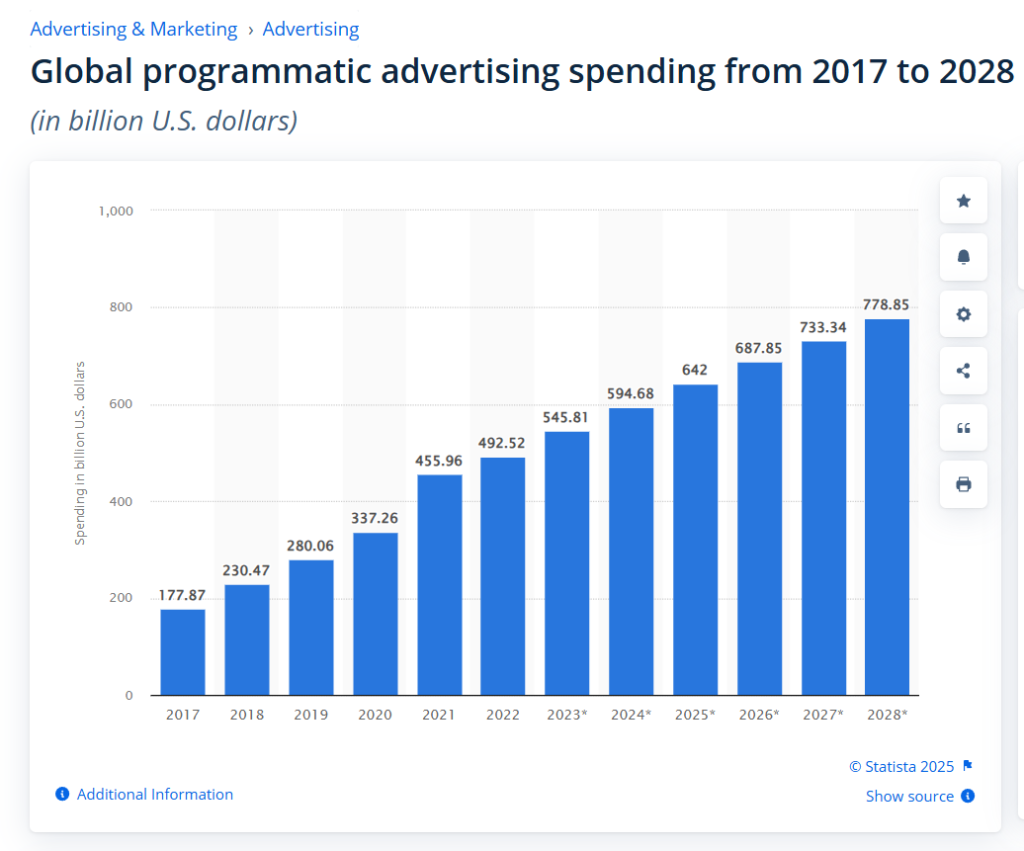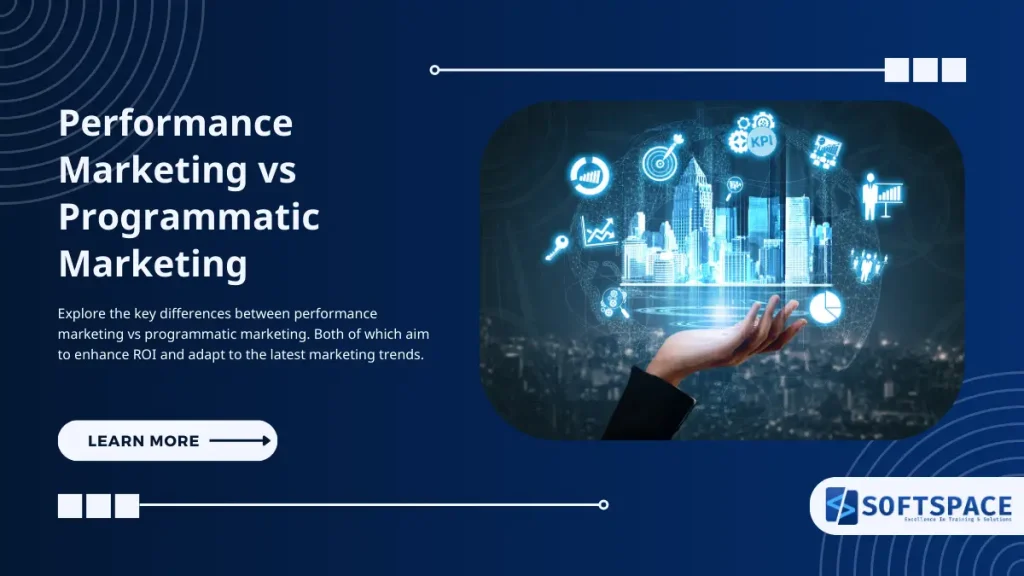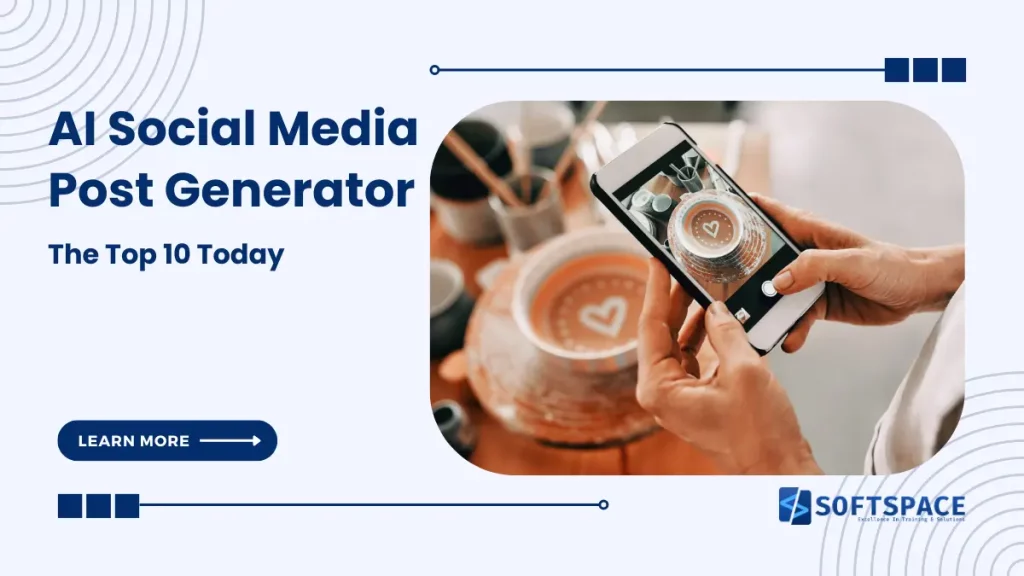In today’s digital landscape, marketers are constantly seeking the most effective ways to reach their target audience and maximise return on investment. Two approaches that often spark debate in marketing circles are performance marketing and programmatic marketing. Whilst they may sound similar—and indeed share some common ground—these strategies operate quite differently and serve distinct objectives.
As businesses grapple with allocating their marketing budgets, understanding the nuances between these two approaches has become increasingly crucial for making informed decisions that drive meaningful results. So, performance marketing vs programmatic marketing; what should you choose for your business?

Performance Marketing vs Programmatic Marketing
| Performance Marketing Metrics | Values |
|---|---|
| Average Conversion Rate | 2-5% |
| Typical Cost-per-Click (CPC) | £0.80-£4 |
| High-performing ROAS | 3:1 or higher |
| Programmatic Marketing Metrics | Values |
|---|---|
| Projected Global Spend by 2030 | £109.8 billion |
| Digital Ad Spend Share | Over 80% |
| RTB Auction Win Rate | 60-70% |
Key Industry Benchmarks
| Metric | Performance | Programmatic |
|---|---|---|
| Click-Through Rate | 1.8-3.2% | 0.15-0.45% |
| Brand Safety Score | 92% | 85% |
| Average Campaign Setup Time | 24-48 hours | 1-4 hours |
| Real-time Optimization | Limited | Extensive |
| Minimum Budget Requirements | £500-1000/month | £2000-5000/month |
Programmatic Marketing Stats (2023-2024)
| Metric | Data |
|---|---|
| Global Market Size | $127.5 billion (2024) |
| Growth Rate | 15.3% YoY |
| Programmatic Ad Share | 72.5% of all digital display |
| Average CPM | $2.80-5.50 |
| Viewability Rate | 65.3% |
| Mobile Programmatic Share | 75% |
Defining Performance Marketing
Performance marketing stands as a highly measurable form of digital marketing, laser-focused on driving specific actions from consumers.
In 2016, marketers worldwide started recognising performance marketing’s potency, given its precision in quantifying success through tangible outcomes. This marketing strategy primarily focuses on generating leads, driving conversions, and enhancing customer acquisition, making it particularly appealing for data-driven businesses.
Remarkably, it’s not about merely increasing visibility; rather, it’s about ensuring each interaction brings value. This dedicated approach maximises the effectiveness of marketing pursuits while aligning expenditures to result-oriented metrics, fostering dynamic and responsive advertising campaigns.
Reflecting the anatomy of the modern market, brands now see performance marketing as a necessity. It equips marketers with the tools to monitor the entire funnel, optimise real-time strategies, and maintain accountability for each marketing rupee spent, empowering businesses to surpass conventional limits.
By understanding how efforts are yielding returns, businesses can cultivate a culture that celebrates continuous optimisation and enduring success.
Defining Programmatic Marketing
Programmatic marketing automates digital advertising processes.
Through programmatic marketing, brands can tap into data depths. This approach allows for more precise segmentation of diverse audiences, leading to an increased relevance of each campaign message. Essentially, marketing professionals can harness the power of algorithms to focus their advertising efforts on potential consumers who exhibit tendencies aligning with brand objectives.
Automation elevates targeting and resource allocation.
Brands leveraging programmatic techniques can – in real-time assess which platform offers the maximum engagement potential for any given moment – thus making campaigns sophisticated yet precisely focused.
In today’s fast-evolving digital landscape, programmatic marketing equips businesses with an unparalleled ability to strike the right chord at the right moment. With an estimated 2023 market value that continues to rise, it demonstrates not only tremendous growth but also its transformative power in redefining advertising dynamics around the globe.
Key Differences: Performance Marketing vs Programmatic Marketing
Performance marketing, unlike programmatic marketing, focuses more on measurable results and direct response tactics such as clicks, leads, or conversions.
In essence, performance marketing operates on a pay-for-performance model, where brands pay for specific actions, establishing a quantifiable return on investment (ROI). On the other hand, programmatic marketing centres around automated ad purchases, optimising the acquiring of ad inventory in real-time, and ensuring that the right ads reach the right audience at the right time. Thus, it elevates the efficacy of digital campaigns and offers a broader scope of audience engagement.
Consequently, performance marketing is more outcome-oriented, pursuing immediate results. In contrast, programmatic marketing addresses the broader advertising strategy by refining data insights and applying them to real-time bidding and placements to optimise audience reach.
Both performance marketing vs programmatic marketing strategies, with their distinctive focuses, offer compelling advantages. Performance marketing delivers a profound understanding of ROI, emphasizing efficiency, whereas programmatic marketing introduces innovation and scalability, empowering marketers to orchestrate highly targeted campaigns that enhance brand awareness and long-term growth. By skillfully leveraging these differences, companies can position themselves at the forefront of modern marketing excellence.
Objectives of Performance Marketing
The primary objective of performance marketing is to ensure measurable results, focusing extensively on key performance indicators (KPIs) such as clicks, conversions, and return on investment (ROI). These metrics form the backbone of analysing campaign success.
Such straightforwardness lends power to this marketing approach, offering clarity in the measurement of outcomes. The detailed tracking enables marketers to fine-tune their strategies in response to real-time data.
Moreover, businesses aim to reduce customer acquisition costs, fostering efficiency that maximizes returns (minimising wastage through ineffective advertising) and resources. The focus lies in refined audience targeting to further business objectives.
Businesses leverage this strategy to promote a robust feedback mechanism ensuring agile learning and adaptation. This facilitates not only immediate improvements but also refines future campaign planning.
An essential goal includes building a strengthened brand presence while sustaining budgetary control, and delivering value over volume. Consequently, it allows enterprises to strategically allocate resources where they render the highest returns, ensuring maximum profitability.
Ultimately, the aim is to drive sustained growth by accurately attributing success. Seamlessly integrating feedback into future endeavours, performance marketing continually evolves with consumer behaviour, setting a benchmark for excellence in results-driven strategies.
Objectives of Programmatic Marketing
The primary goal of programmatic marketing is streamlining advertising processes to achieve precision and scale across diverse digital platforms.
Through automation, programmatic marketing aims at a harmonious symphony between creativity and technology, enhancing campaign efficiency. It seeks to identify and target specific audience segments with personalised messages, thereby driving engagement while reducing unnecessary expenditure. This dynamic approach empowers marketers to make data-driven decisions that are grounded in real-time insights.
Furthermore, programmatic marketing strives for a consistent, ubiquitous presence across the digital landscape. By leveraging data analytics, it ensures that brand messages reach the right audience at the optimal time, thereby fostering improved conversion rates and elevating customer satisfaction.
In addition, programmatic marketing is designed to optimise return on ad spend by leveraging sophisticated algorithms and machine learning. It aspires to deliver more measured results by continually refining and adjusting campaigns based on real-time feedback. This approach not only enhances brand visibility but also ensures sustained brand growth in an ever-evolving digital ecosystem.
How Performance Marketing Works?
Performance marketing is a data-driven approach that focuses on achievable objectives, ensuring optimal resource allocation and maximising return on investment for marketers.
Campaigns are meticulously crafted around measurable metrics like clicks and conversions.
This model of marketing empowers brands to allocate budgets based on successful outcomes. Adaptive strategies allow for a pivot in tactics, optimising marketing efforts when certain channels outperform expectations.
By continually evaluating performance metrics, marketers can make informed decisions that provide a competitive edge. The insight gained from these analytics not only shapes future campaigns but also aligns them more closely with consumer needs and preferences. Thus, performance marketing is often heralded as delivering “right-outcome” strategies that catalyse success across digital platforms.
How Programmatic Marketing Works?

Programmatic marketing, at its core, leverages automation to buy digital advertising in real-time through complex algorithms and bidding.
In essence, programmatic marketing functions as a sophisticated technological orchestra that harmonises data, analytics, and artificial intelligence to execute precise advertising campaigns. This approach allows marketers to engage with the right audience at the right moment, thus amplifying the potential for meaningful interactions. By utilising technology, advertisers can optimise campaigns dynamically, allocating budgets intelligently and enhancing advertising efficacy.
Moreover, this method operates via a framework of automated transactions, seamlessly integrating data insights. As advertisers articulate parameters, the system deftly selects the most promising opportunities, ensuring optimal impressions that resonate with the intended audience.
Consequently, programmatic marketing provides a transformative pathway in advertising, offering unparalleled scale, speed, and efficiency. It allows organisations to transcend traditional marketing constraints, empowering them to efficiently reach audiences across diverse networks, thus elevating brand visibility and engagement. Through this modernisation of advertising tactics, programmatic marketing emerges as a beacon of innovation, propelling brands into a prosperous future within the digital landscape.
Performance Marketing Strategies
- Performance marketing is a results-driven method that aligns closely with ROI, empowering marketers to adapt, refine, and enhance their strategies based on quantifiable outcomes. It facilitates data-led decisions.
- This approach places focus on conversion metrics and direct outcomes instead of speculative investments. By leveraging insights, businesses can optimise campaigns.
- Moreover, ongoing analysis allows marketers to pivot their strategies, ensuring expenditure aligns with desired objectives. This adaptability fosters continuous improvement.
- Successful performance marketers frequently utilise A/B testing, creative optimisation, and attribution modelling as tactical tools for maximising returns. These methods support data-driven campaign excellence.
- Harnessing technology is integral to performance marketing, enabling real-time adjustments and audience targeting. Incorporate advanced analytics to decipher consumer behaviour, achieving precision in strategic executions.
- Ultimately, performance marketing’s power lies in its capacity to make every metric matter. Prioritising effective measurement leads to transparent, accountable, and thriving marketing campaigns.
Programmatic Marketing Strategies
- In the ever-evolving world of digital marketing, programmatic marketing represents a paradigm shift, facilitating a seamless automation of media buys, and harnessing an extraordinary technological prowess like never before.
- Using sophisticated algorithms, marketers tap into real-time bidding, ensuring advertisements are precisely placed to reach the most relevant audiences.
- Indeed, programmatic strategies offer unprecedented agility, enabling brands to optimize their reach (audience interactions rapidly recalibrated) and tailor the delivery of their content.
- These strategies hinge on leveraging vast data reservoirs to pinpoint consumer behaviours and anticipate trends, empowering marketers to make informed decisions.
- By harnessing machine learning, predictive analytics become indispensable, refining targeting accuracy and campaign performance, thereby transforming the advertising ecosystem, and placing consumers at the heart of the experience.
Thus, staying ahead in today’s market necessitates embracing these cutting-edge strategies. Programmatic marketing holds boundless potential and promises a dynamic future for marketing industry innovators.
Role of Data in Performance Marketing
In the dynamic arena of performance marketing, data acts as an indispensable cornerstone. It empowers marketers to craft strategies that are both insightful and precisely targeted, paving the way for unprecedented campaign efficiency.
Builders of success within this landscape utilize data-driven insights to achieve measurable outcomes.
Access to comprehensive datasets enables marketers to elevate their strategies, integrating them into a tapestry of channels that render timely, relevant engagement with potential customers, thereby enhancing conversion rates, retention, and the fulfilment of marketing objectives.
Furthermore, data sharpens the efficacy of campaigns by serving as the compass that guides the entire marketing endeavour. It enables practitioners to navigate the complexity of digital terrain with precision, offering metrics that inform every decision from ad spend optimisation to content strategy. For savvy marketers, data is the “fuel” that propels their success.
Role of Data in Programmatic Marketing
In programmatic marketing, data serves as the engine that ensures the seamless delivery of advertisements to the right audience at optimal times.
In 2016, eMarketer forecasted that programmatic advertising would account for a significant share of digital display ad spending, indicating the already burgeoning reliance on data-driven strategies in the market landscape.
Today, it’s not merely about bidding for ad space; it’s understanding the consumer’s journey with precision through the extensive use of behavioural data that goes beyond traditional metrics to encompass real-time interactions and predictive modelling.
Data allows for the creation of personalised ad experiences, ensuring that the campaign’s message does not just reach the audience but resonates deeply with them. By leveraging data, marketers can identify and target niche segments, resulting in maximised returns on investment and more effective allocation of marketing budgets.
Ultimately, data underlines the shift from mass marketing towards tailored engagement in programmatic marketing.
Benefits of Performance Marketing
Tailored strategies enhance marketing efficiency significantly.
Performance marketing stands out for its result-oriented approach. The main advantage lies in the direct correlation between marketing actions and measurable outcomes, allowing businesses to allocate resources more effectively. Consequently, marketers have learned to focus on strategies that drive conversions and maximize what they gain from every rupee spent on advertising campaigns.
Data-driven insights guide strategic enhancements.
With performance marketing, real-time feedback becomes a robust mechanism for optimization. As marketers amass more data about consumer interactions, they can dynamically tweak campaigns to ensure peak performance, evolving strategies based on real evidence rather than assumptions – a process that fosters continuous improvement and profitability.
Moreover, performance marketing inspires innovation through rigorous testing methodologies. Marketers are encouraged to experiment by deploying A/B tests and analysing progressive ad formats, continuously refining strategies to find the optimal blend that resonates best with audiences.
This approach of perpetual improvement not only yields a compounding return on investment but also engenders a culture of excellence and forward-thinking, essential in sustaining competitive advantage amidst the rapidly evolving digital landscapes.
Benefits of Programmatic Marketing
Programmatic marketing offers exceptional efficiency, allowing for automated ad purchases and placements that maximize value and impact.
By leveraging sophisticated algorithms and real-time bidding, programmatic marketing ensures an engaging, targeted approach, reaching the right audience at the opportune moment. This real-time process not only enhances ad performance but also smartly allocates budgets to secure the best possible outcomes.
Notably, programmatic marketing provides insightful analytics that helps marketers understand their audience more deeply. These analytics empower marketers to tailor future campaigns by offering granular insights, enabling precise targeting and customization that align with audience preferences and behaviours.
Additionally, the flexibility inherent in programmatic marketing extends far beyond simplistic ad placements, fostering a vibrant ecosystem where scalability and precision coalesce seamlessly. Embracing this technology enables businesses to navigate and thrive in complex markets, ensuring they remain at the forefront of digital innovation and are positioned to capitalize on emerging trends with confidence.
Challenges in Performance Marketing
Performance marketing, while highly effective, poses its own unique set of challenges that marketers must adeptly navigate.
In the 2020s, consumer expectations, a constantly shifting digital landscape, and the explosion of data have combined to make the execution of performance marketing strategies more complex. Marketers must continuously adapt to new tools and platforms to ensure messaging sustains its relevance and resonance.
Moreover, it’s no small feat when one considers the marketer’s obligation to deliver a spectrum of high-stakes outcomes through performance marketing. The necessity to balance budget constraints with innovative strategies that achieve high conversion rates can indeed be a Herculean task.
Furthermore, the challenge of data accuracy persists, wherein marketers need to harness accurate data that’s actionable. This is crucial not just for crafting effective campaigns but also for fostering trust among increasingly savvy consumers, who demand transparency and authenticity.
Yet, by overcoming these challenges, committed marketers armed with resilience and creativity can unlock remarkable potential.
Challenges in Programmatic Marketing
In the ever-evolving realm of programmatic marketing, navigating through complexities requires determination and insightful strategies to harness its full potential.
Since 2016, programmatic advertising, a dynamic revolution reshaping marketing, continuously faces hurdles like fraud and the lack of data transparency, necessitating vigilance and adaptation from marketers striving to optimize their advertising investments.
Moreover, it’s not just about fraud; there’s the intricacies of talent, with a shortage of individuals who possess a profound understanding of the technology woven into the seamless execution of programmatic campaigns.
Balancing the nuances of the technology, marketers need to ensure their strategies don’t fall prey to the 3 V’s—volume, variety, and velocity—while simultaneously maintaining an unwavering focus on compliant and ethical data usage.
By persevering through these trials, savvy marketers can turn obstacles into opportunities, shaping exceptional programmatic marketing initiatives that truly shine.
Choosing Between Performance and Programmatic
Knowledge of the distinctive strengths of each approach is essential when deciding between performance marketing and programmatic marketing. How do you choose which avenue best suits your brand’s ambitions?
In 2023, performance marketing, with its data-driven focus on tangible results, provides clarity and an assured return on investment. Its essence lies in measurable actions like sales, leads, or clicks, ensuring accountability with every advertising rupee spent.
Conversely, programmatic marketing offers a breadth of reach through automated processes fueled by real-time data, enabling targeting at scale with precision. It’s perfect for those seeking broad audience touchpoints while maintaining personalized interaction.
The decision-making hinges on the objectives you’ve set. Performance marketing ideally suits brands demanding transparent and quantifiable results, while programmatic shines in creating expansive brand awareness with engaging, dynamic content.
Ultimately, aligning your strategy with your goals will illuminate the ideal path, marshalling resources effectively towards triumphant marketing outcomes.
Industry Trends in Performance Marketing
In recent years, performance marketing has experienced a robust surge, fueled by an insatiable demand for transparency, accountability, and efficiency in the advertising landscape. As brands pivot towards more data-centric approaches, a remarkable shift is noticed in their advertising strategies.
Advanced analytics tools play a pivotal role in this transformative journey, reshaping the marketing ecosystem.
Platforms like Google Ads and Facebook, among others, lead the charge in this evolution, integrating AI (artificial intelligence-driven enhancements) and automation.
Such tools equip marketers with unprecedented capabilities to optimise campaigns and achieve higher conversion rates, transforming the management of advertising investments.
Moreover, a focus on omnichannel performance marketing is redefining the consumer journey, ensuring seamless brand interactions. Brands now aim to synchronise various touchpoints, maximising their consumer outreach while maintaining a consistent message across platforms.
Undoubtedly, the era of data-driven decision-making is here to stay. Performance marketing trends indicate a future where intuitive strategies and cutting-edge technologies align to redefine marketing success.
Industry Trends in Programmatic Marketing
The programmatic marketing landscape has witnessed transformative shifts, fundamentally evolving the advertising industry and changing how brands allocate their budgets.
Data-driven insights are fuelling precise audience targeting at an unprecedented scale.
One notable trend is the enhanced integration of machine learning algorithms, making programmatic campaigns more efficient by predicting consumer behaviour with higher accuracy, ultimately maximising returns on marketing spend.
With privacy regulations evolving, programmatic marketing is adapting through innovative strategies like contextual targeting and leveraging first-party data. This signifies a commitment to responsibly aligning consumer privacy with advertising effectiveness, as emerging technologies continue to unveil new realms of opportunity and efficiency. As Mahatma Gandhi said, “Be the change,” and programmatic marketing embodies this dynamic ethos with each technological advancement.
Conclusion
Whether to focus on performance marketing or programmatic marketing isn’t necessarily an either-or decision. The most successful marketing strategies often incorporate elements of both approaches, tailored to specific business objectives and target audiences.
Performance marketing offers the accountability and results-driven approach that many businesses crave, whilst programmatic marketing provides the scale and efficiency that modern digital advertising demands.
The key lies in understanding your business goals, audience behaviour, and available resources—then crafting a strategy that leverages the strengths of each approach. As the digital marketing landscape continues to evolve, the ability to strategically blend these methodologies may well become the hallmark of tomorrow’s most successful marketing campaigns.

13+ Yrs Experienced Career Counsellor & Skill Development Trainer | Educator | Digital & Content Strategist. Helping freshers and graduates make sound career choices through practical consultation. Guest faculty and Digital Marketing trainer working on building a skill development brand in Softspace Solutions. A passionate writer in core technical topics related to career growth.



